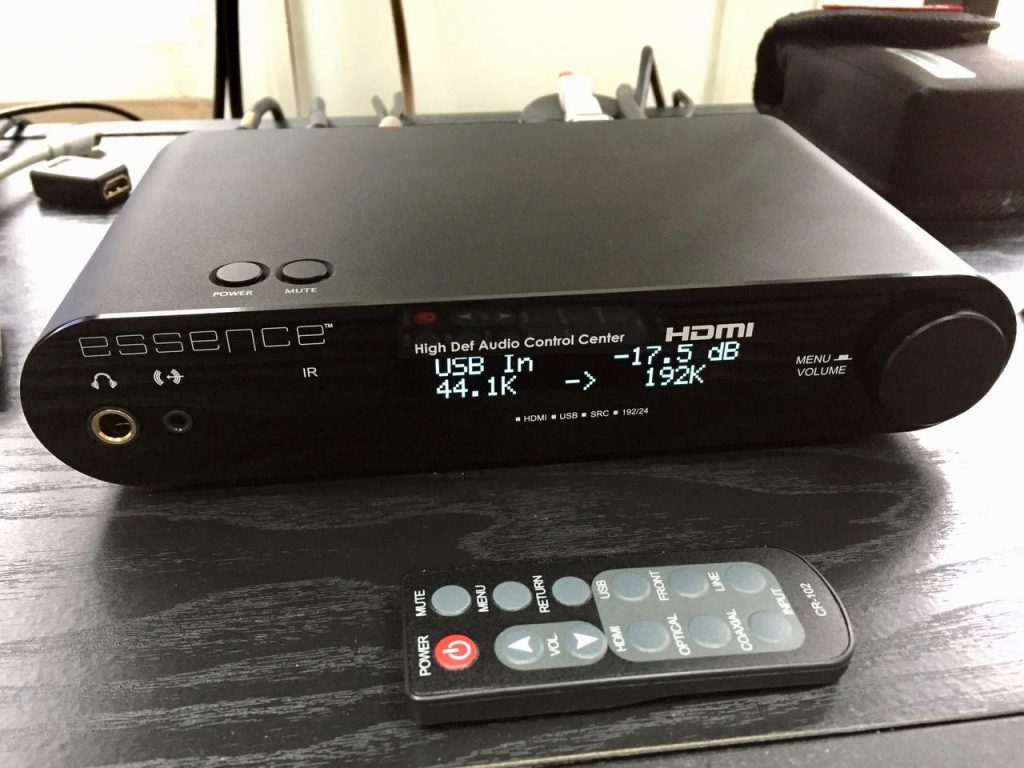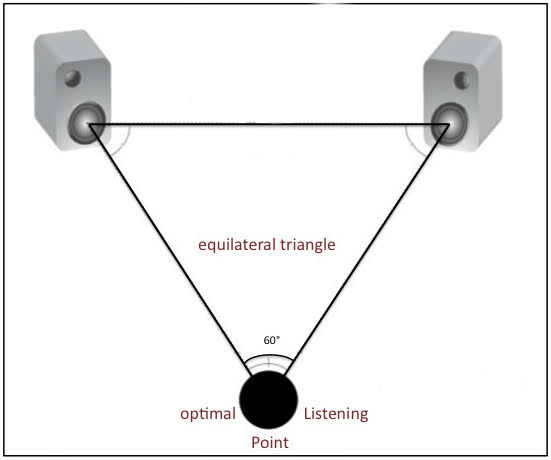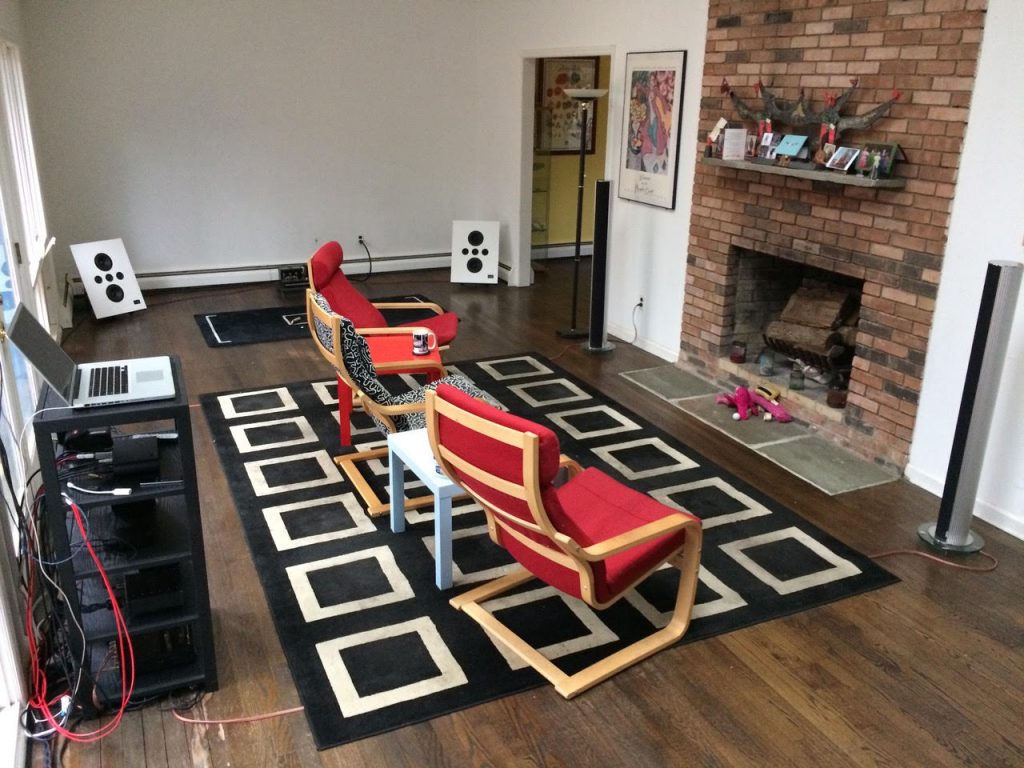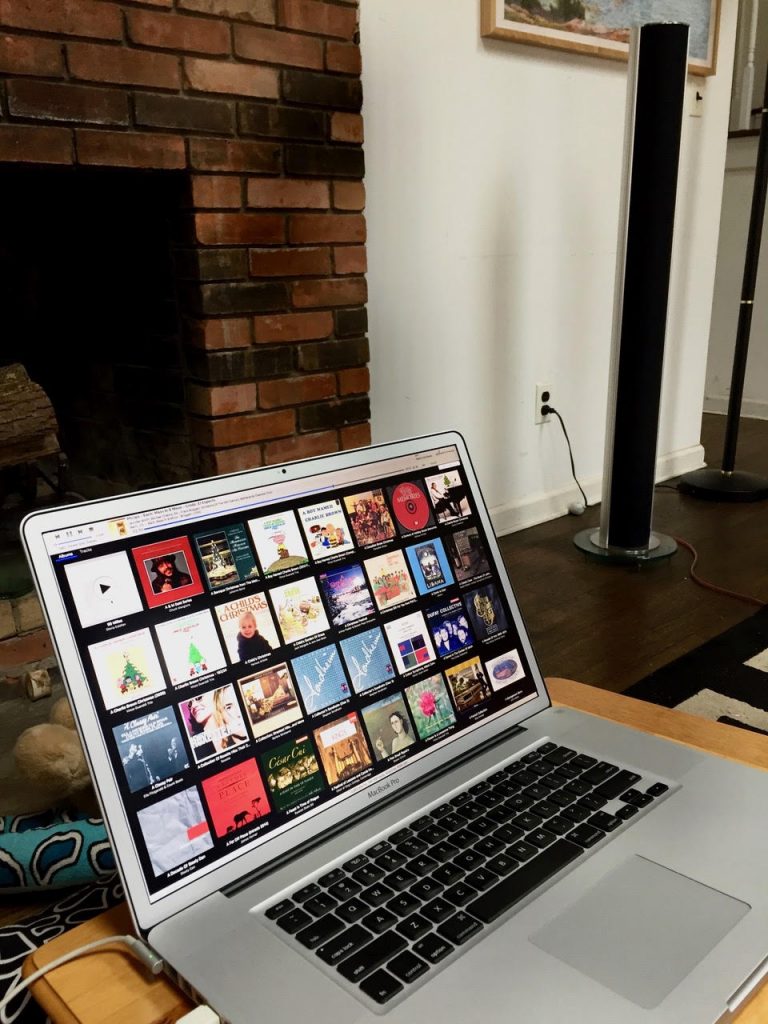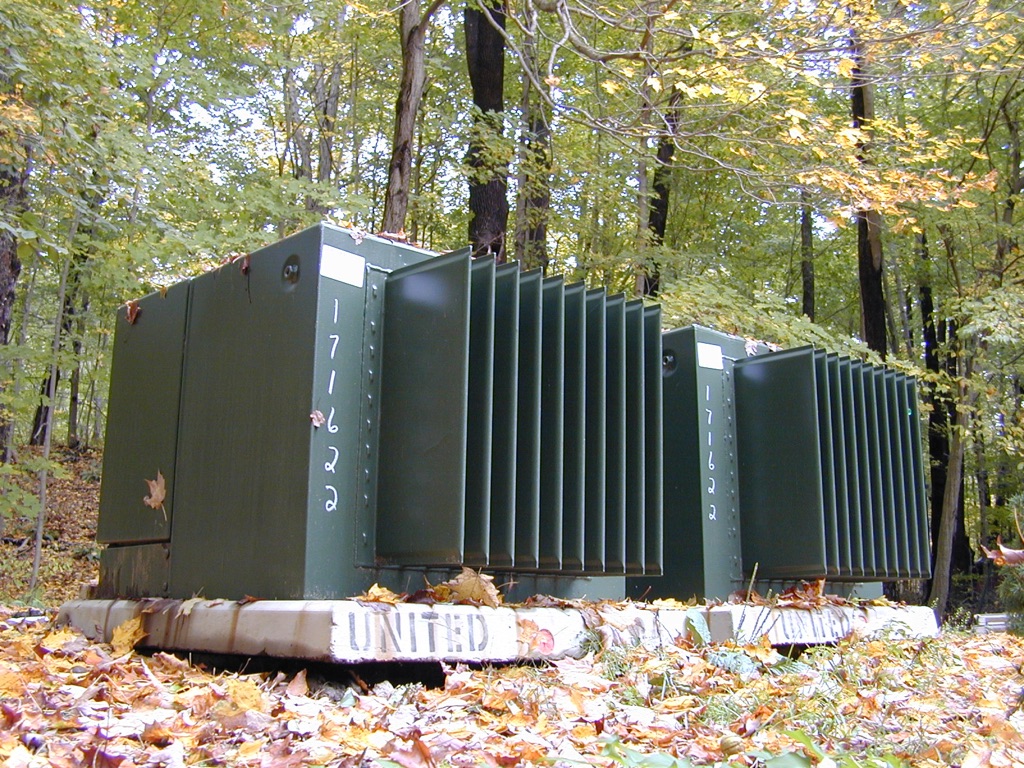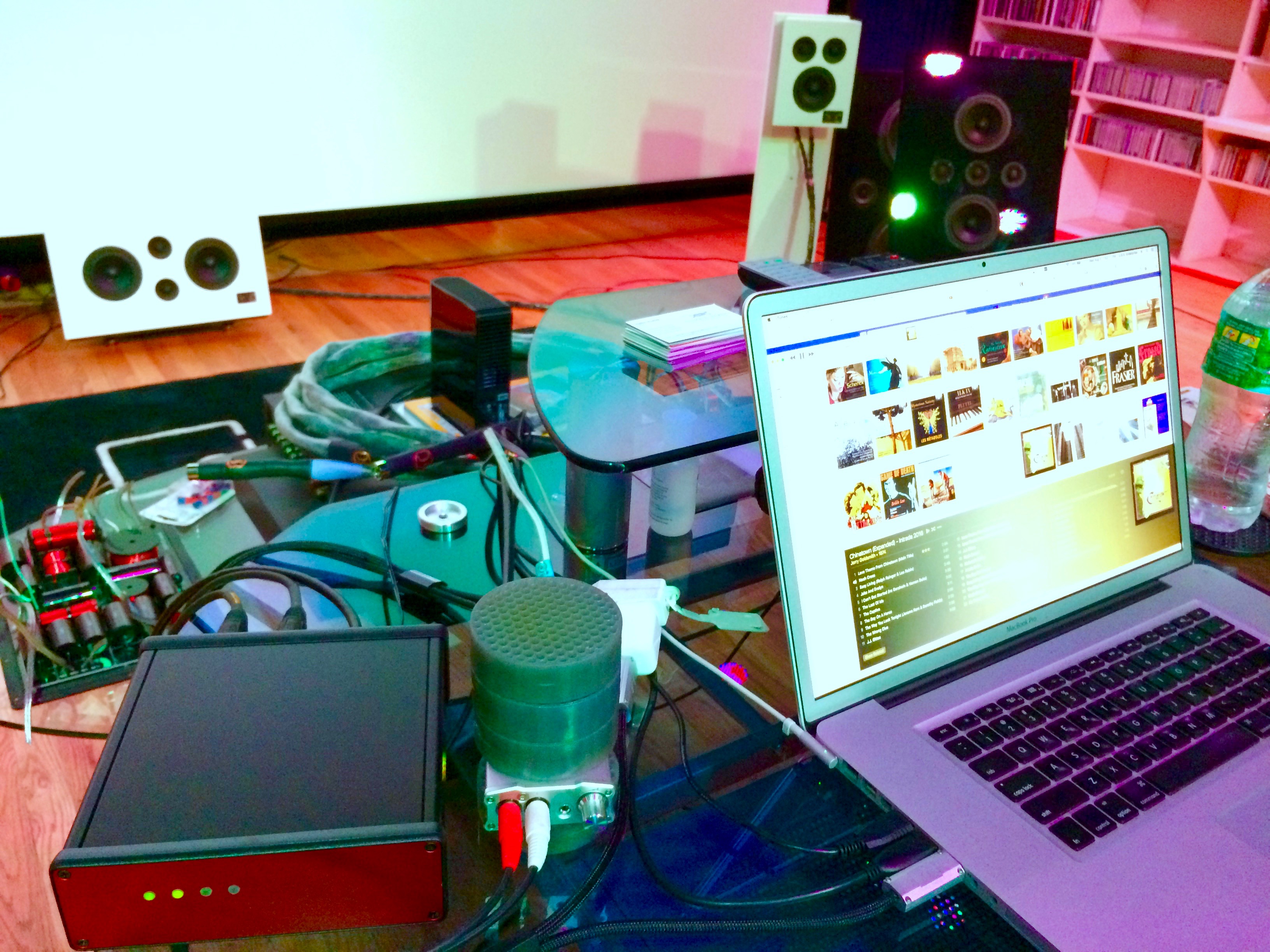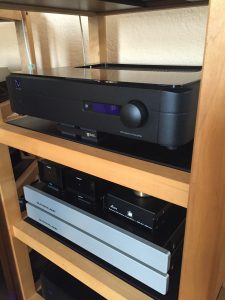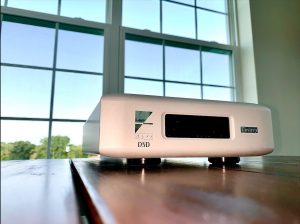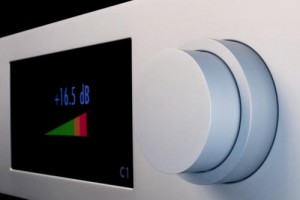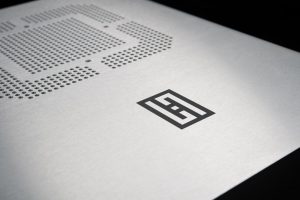Introduction – The Illusion of "LIVE"
Imagine something hard enough and it often materializes. About this time last year, I was engaged in several speaker reviews, most notably the Waterfall Audio Niagara Glass loudspeakers (see my review, HERE) and I thought to myself, "I wonder what effect the digital to analog conversion (DAC) stage and any step-up amplification (required by most speakers unless self-powered) has on the overall sound quality in comparison to differences made by changing the speakers, themselves, for example?" Well I did ask for and receive both several new and intriguing pairs of speakers (the Ceratec Effeqt Mk. IV. for one as seen in some of the photos), but also several digital to analog converters (including headphone output and sound enhancements—such as the ifi Micro DSD) for review. A standout was this stunning new digital control center, designed and offered exclusively and directly worldwide through Essence For High Res Audio by Bob Rapoport; it is at the top of my list to tell you about. Your money has never gotten you more in terms of real "high-end" audiophile sound these days than ever before—no matter what source you are starting with!
For me the term audiophile describes my personal pursuit of sound fidelity which recreates the sonic impression of being present with LIVE musicians at a real event. Further, it entails a level of artistry in capturing and producing physical albums available for sale on CD, BD, SACD, and LP; at their core, they recreate the very physical—palpable—realistic sensations of live music, even years after the fact and long after the musicians have past on to other dimensions. LIVE authenticate music projected from your playback system should be the defacto standard of audio fidelity, capable of delivering spine tingling chills.
In any case, many things contribute to this impression of listening LIVE when one is actually hearing an artificially constructed mirage of sound. Your brain should be fully engaged in the hearing process, reconstructing an aural facsimile of the event in your mind. When all is going well, ideally, you are hearing your favorite recordings as though they were real and you were (are) there. You can sense this because the tactile qualities evidenced in a full range professional recording(20Hz – 25kHz) heard over near full range (40Hz – 20kHz) phase accurate speakers CAN BE really amazing while sitting in an equilateral triangular arrangement deployed in a controlled listening space (that means absorbing near field and midfield reflections, selectively and carefully… but not completely):
This specific 60-degree orientation can create quite a convincing sonic mirage (illusion) of people performing right in front of you, and even of your feeling transported to the recording venue in a sort of sonic time machine. But this illusion depends upon the particulars of the recording, engineer, microphones, mix, etc. The impression of hearing actual live music rather than a facsimile has at it's core: 1) a certain authentic unrestricted dynamic envelope with deeply extended frequency response at both ends of the spectrum together with, 2) a palpable, physical presence projected separate from the speakers which compels your body and mind to believe that the illusion it is experiencing is real (again, when properly set-up and projected through a well designed pair of loudspeakers in a controlled listening situation). This produces 3) an unmistakable jaw dropping feeling to anyone who has ever experienced a true high fidelity listening system—it's like sonic virtual reality! If you've only heard mid-fi sound where the image never leaves the speaker locations then you will have absolutely no idea what I'm talking about. Yet the pursuit of this refined and often mythical aural illusion has the added benefit of putting each of us directly in touch with the music we love so much (and the emotions we feel while listening to it). And in a world with such fast-paced living and little time for genuine concentration on any one thing, music is an area where we all can draw some necessary comfort and joy without apology.
Many reading this will agree when I point out how isolated we've all become from each other even at what appears to be the height of the technological communications era: 1/5 of the world's population have a smart phone capable of talking or texting any of the other 1.5 billion people at just about any time. One can also listen (and watch) superior quality Audio/Video media with a greater variety of choices then at any other time in human history; CD, BD, File Downloads, Streaming HD Audio, and even still LP and Tape (who would have thought?). And since most listening occurs (more often then not) via headphones or ear speakers of some sort, this actually compounds the way in which we perceive sound, in particular by showcasing two very markedly different approaches to audio reproduction: Speakers vs. Headphones. In the case of speakers (as I pointed out above) proper location and seating position are required at a minimum (plus acoustic treatment) for good 3D sound imaging to occur most often (should it be present in the recordings being auditioned—and not every recording can produce these spatial and dimensional sound cues). In the case of headphones or ear speakers, the sound is automatically located 180-degrees on either side of your head and produces a distinctly "in-your-brain" soundfield that mostly images as a flat plain or disk of no dimensional thickness going straight through your noggin. Like it or not, headphones and ear speakers are not going away anytime soon. You can even find them now (as well as dedicated amps for them with either tubes or even class-D technology) at whopping prices that often exceed the value clearly obtained using well selected and even affordable loudspeakers with proper set-up in a dedicated listening room!
Well… after a very long year that included many, many auditions with DACs, Wires, Speakers, Headphones, Amps, Power Conditioners, Equipment Isolation Systems, Measuring Gear, and many tweaks like fuses, anti-static guns, and electro-magnetic sponges, I located a considerable number of new and old favorite gear in ever category, and these have now resurfaced into my working playback systems, of which you will be hearing more during the coming year's reviews and columns from the Kipnis Studios . Such is the case with a cherished Theta Digital - Generation III (era of 1993-7) DAC and Snell (Boston Acoustics) M&C Speakers (1996-1999) along with classic Sony DAT & MD Recorders (1990-1996) as well as vintage Crown Macro Reference Amps (1993-95).
Here I was receiving several DACs for close audio inspection, measurement, technical analysis, and critical comparison to other DACs on hand for review (including Tommy O'Brien's DAC DAC (both TL & HS versions), Thorsten Loesch's ifi Micro iDSD, Paul McGowen's PS Audio Powerwave DAC II, Mike Moffat's updated Theta Digital Gen VIII Mk. IV) along with great sounding designs from the near and distant past in the same categories. In my review of the Digital Amplifier Company's DAC HS Version, read that HERE. I listened very closely to the first of a new variety of "number crunchers", technology which we so often take for granted as a part of any AV device these days. But on your cell phone or tablet, audio can be handled well or poorly; it all depends on the device and who designed it, the software running on it, and the Apps in use. So when it comes to outboard DACs, the goal (I hope and so should you) is to translate whatever the binary numbers (1s & 0s) representing the music that was created by skilled producers and engineers all the way back from that infernal dichotomy that is digital into the continuous sonority that is analog… and which our ears can hear while our minds interpret and feel!
Given that doing this slight of hand (that is turning numbers back into sound) seems so simple in today's daily life, it's nice to know that some folk out there still believe in exploring a deeper quality to the reproduction of music than the average person might consider worthwhile or even necessary. Clearly, music plays an important role by pulling on our heartstrings. Listening for more of the "reality" recorded in each track or album we hear on our Stereo Systems makes sense on so many levels… doing it sensibly and affordable even more so. After all, it is our time and money we are talking about. Which is why I'm delighted to present a truly amazing center piece for just about anyone that I've been enjoying for more than 6-months now; a device whose central concern is the ease and fidelity of enjoying your favorite media (physical and streaming). This wonder is known as the Essence HDACC (High Definition Audio Control Center)—a Digital-to-Analog hub ($499); again designed and created by Bob Rapoport.
In conversation earlier last year, Bob had mentioned this DAC Control Center to me, just in passing. And I confess I was both intrigued but also speculative about how it's sonic qualities might be marginalized given such competitive pricing. Surely a quality Digital to Analog converter (as well as a whole AV media control center with built-in A/D for analog sources) must inherently involve a certain amount of bulk, heft and cost in order to get even remotely close to the sonic mark, right? Well… I take it all back. The HDACC indeed does fulfill most all of my expectations regarding such a critical item in any digital (and analog) audio (and video) entertainment system. You will no doubt come to agree with me, after reading the below detailed review, offering nearly 500 hours of listening and testing remarks.
Initial Observations
(…the reviewer toils in obscurity)
Starting with a fresh from the factory product is always a good opportunity for a reviewer to test their hearing, their system integration, and the choices of musical and sonic delights used in the painstaking process of ascertaining a particular piece of gear's favored tendencies or added coloration's. So when starting "cold" out of the box and fresh, it is very important to understand how a truly high end audio system, which resolves spatial and tonal qualities easily for the end listener, WILL reveal qualities that strain the sound reproduction (sound electronic) in terms of transparency until the gear is properly warmed up (20 min – 1 Hr. – each time) and broken-in (Up to 500 hours+). This is so often overlooked that the careful reader might well wonder if any of this audio WANKERY can even really be measured or agreed upon by so called experts. Roger Scoff just mentioned in his column of the pure futility of trying to understand speaker measurements with regard to actual sound quality heard. To that I implore you to gather your 10 favorite recordings (as I often do… only more so on all counts) and start listening to just a single track again, and again, and again, and again… while changing but a single item of audio concern; be that Absolute Polarity, a cable, different DACs, or even vibration isolation under a component—it doesn't matter. Some can hear a difference, some want to hear a difference but can't, and some don't want to hear any difference so they don't, won't, or can't!
Now, here is what I heard and noticed initially when comparing the "cold" HDACC with the "warmed-up" Digital Amplifier Co.'s DAC DAC (Both TL & HS versions were on-hand) in a comparison using a variety of favored tracks that you might consider giving a try yourself in order to easily resolve (potentially) minor or major variations in playback fidelity:
Recordings used (in order)
- Chesky Jazz Vol. 1 – Track 4 w/ David Chesky "Club de Sol"
- Chesky Jazz Vol. 2 – Track 1 w/ Sara K "Miles Away
- Chesky Jazz Vol. 1 – Track 1 Paquito DiRivera "Tico Tico"
- Chesky Jazz Vol. 1 – Track 3 Ana Caram "Viola For a De Mora"
- Chesky Jazz Vol. 1 – Track 5 Phil Woods "Charles Christopher"
- Chesky Jazz Vol. 1, Tracks 22 (+ Polarity) & 24 (- Polarity) "Waltz For Libby"
- Chesky Jazz Vol. 2, Track 7 Orquesta Nova "Wapango"
- Chesky Jazz Vol. 2, Track 8 Clark Terry "Brushes & Brass"
Initial Sound and Observations
(just plugged in = cold) USB Input from MacBook Pro / Balanced XLR Output to Golden Cherry Amps / Crown Macro Reference (Audirvana + 1.5.12 – Volume -8.5):
- The included DC Power adapter's chord is indeed very short—½ length of the Digital Audio Company's DAC DAC; it absolutely requires an extension cord (which is what I used), unless you have a nearby power strip or (better yet) power conditioner. I'd like to see a longer chord as an option.
- Fixed Volume does not show on main display but instead continues to ascend and descend—volume still looks like it works even though sound is fixed volume (a menu adjustment fixed this).
- Sound is detailed but slightly flatter than DAC DAC TL - Chesky Jazz Vol. 1, Track 4 w/ David Chesky "Club de Sol" & Chesky Jazz Vol. 2, Track 1 w/ Sara K "Miles Away" : Much more visceral Depth & Width on TL: space is accurately portrayed on HS version—wider, all the way around my listening position and deep into the soundstage imaging area (Ologe 1, 5 & 10, Ceratec effeqt Mk, 4, Symdex Epsilon Control Room Monitor Loudspeakers)..
- Sound is slightly louder at same Audirvana volume setting than DAC DAC TL
- Dynamics not as good as DAC DAC TL, flatter and a little harsher, HS version even more dynamic then HS.
- Display does NOT time-out (go dim is how I read that) as indicated in settings (instead, it returns to the top tier of the menu at full brightness). A menu dimmer option with time-out to black would be a nice option in a future model.
- Slight Haze to the sound heard of cymbal and wood block - Chesky Jazz Vol. 1, Track 1 Paquito DiRivera "Tico Tico" & 3 Ana Caram "Viola For a De Mora" sounds a bit fuzzy.
- Trailing edge of transients is slightly muffled on comparison to the DAC DAC - Track 1 Sara K "Miles Away", Bass and guitar are clearer and much more spacious on TL… HS sounds more like HDACC but vocals stand off of the background better.
- Does not have that warm 3D glow of the TL, nor the depth, width, height of the HS: DAC DAC produces very 3D images with deep soundstage that wraps around my listening position.
- Soft vocals are indistinct - Chesky Jazz Vol. 1, Track 3 Ana Caram "Viola For a De Mora"/ HS clear and resonant, TL Neutral and precise with extremely tight control over individual images and distinctly separate acoustic space all around.
- Left to Right fairly wide on HDACC, but distance is flat and dimensionless - Chesky Jazz Vol. 1, Track 5 Phil Woods "Charles Christopher".
- Generation Loss Test clearly audible - Chesky Jazz Vol. 1, Tracks 22 & 24 "Waltz For Libby", Snare Brush sounds fuzzier with HDACC.
- No Absolute Polarity Adjustment - Chesky Jazz Vol. 1, Track 18 & 20 test clearly audible throughout.
- Bass is a little bloated, some overhang - Chesky Jazz Vol. 2, Track 1 Sara K "Miles Away".
- No plastic film on review front panel so some minor Scratches and Scuffs.
- No artwork on packaging - external box.
- Front Panel Protocol is TREE Based Architecture, I find this clunky to use, Suggest add RETURN button on top instead of click through on volume knob.
- The DAC DAC TL = Tube like has rounded qualities and slightly homogenized imaging where Acoustic and Instruments are all part of a single image / HS = High Spec where images are each separate and distinct while remaining in front of and within the acoustic space; HDACC sounds dimensionless... initially.
- HS offers cymbals that have a VERY long reverberant tail that is separate from everything else in the image / TL is rounder and softer with the cymbal clearly imaging in space but also part of the acoustic / HDACC sounds flat by comparison… instruments do not occupy there own space and are one big image that gets more congested with greater volume level of source - Chesky Jazz Vol. 1, Track 4 David Chesky "Club de Sol", Piano does not resolve the hammer sound (Leading edge) versus the tone (Tail) nor the acoustic space
- USB output data in MIDI Controller shows: USB 2.0 rather than the name of the device = HDACC 2.0; again, something perhaps for the next iteration.
- HDACC only goes as high as 192/24—which is fine for me, but some may demand DSD, etc.
- On-board Signal rate converter subtly changes the timbre and spatial character, slightly duller at top end (more burnished sound) and imaging more spread-out horizontally (diffuse) with shorter ambient tail - Chesky Jazz Vol. 2, Track 7 Orquesta Nova "Wapango" & Track 8 Clark Terry "Brushes & Brass".
- Such great connectivity begs the question about adding Apple Airplay, Bluetooth HD Audio, etc. some of which can handle 192/24.
- Remote sometimes keeps going with Volume adjustment continuing after button is let go of. Sometimes it also jumps in 3.5 dB steps.
- The unit needs to be turned off and back on sometimes in order for the USB 2.0 to show-up in the MIDI device manager
Later Observations
After Warm-Up (24 hours – Top warm to touch) USB In / Balanced XLR Out (iTunes 12.5.1.12 at 0dB / System at 0-dB Unity Gain / Volume at 13.0 on HDACC):
- Much warmer sounding than yesterday!
- Very 3D and VIVID 😀
- Cymbals cleaner and individuated, airy sounding
- Vocals are now open and authoritative, free from loudspeaker positions
… and that's where I stopped, 'cause I got so involved listening to the music I forgot to write anything else down!
That's how my reviews happen here, day after day: I hook up a new piece of gear, compare it to some other older gear I have longtime listening experience using while listening to a good old reliable and enjoyable variety of music sources, and spend some time (hours each day) closely observing and hopefully divining in print a little bit of what makes one piece of audio (gear) better or worse than another. In particular, does that device work well in the context for which it is being used and does it represent good value doing it's job? In this regard the HDACC outshines most other such addendum products in being fully input and output capable along a very wide range of formats, offering stellar sound (REALLY) at a fraction of what similar sound quality normally costs (thanks to direct sales), and genuinely improving the quality of experience from all your existing sources of sound! The Essence High Def. Audio Control Center (HDACC) will allow you to upgrade your sound quickly and get the most appealing experience from the main two channels of any stereo audio system in ways you might not have imagined could be bettered.
Quite Simply... I love this product, and I enjoy using it EVERYDAY in two or even three different systems! And here is why:
Deep Listening
Bob likes to point out that one of his primary goals in offering the HDACC was to liberate the full resolution audio available of Blu-Ray discs. A page on his website details almost 1000 BD-Music albums currently available HERE (some with video—live concerts, some without) that when played even through the most basic of current BD players (HDCP 2.1) costing less than $100 one can liberate a world of sound most people don't know exists; up to 192 kHz 24-bit straight from the master!
Now I own a lot of discs, BD included. And so when I began listening to some of them up close for this review, I was amazed how great they all sound and considerably better than the same audio coming through streaming (if and when it's available). I listened to Chris Botti LIVE at Boston with the Boston Pops at it was far more immersive and engaging than any other time I've heard the front 2.0 stereo mix. His trumpet playing is so widely expressive that I often got lost in the clear sound he produced coming from one side of the screen to the other. Along with the 1080p image played from an Oppo 105 BD player through the HDACC to my trusty Optoma HD141x 1080p projector, this disc and several others proved to be intoxicating for hours on end.
Another great disc is the historic concert where the New York Philharmonic visited Pyongjang in North Korea. Lorin Mazel has absolute control over one of the finest ensemble to ever play together. The Dvorak 9th Symphony is always a favorite, but here all the more so because of the historic gravity that this concert tour of one performance set, and which was never to be repeated. Sound is surpisingly well balanced with great precision to the imaging which closely follows to camera work. If you couldn't go to Korea to see this and you missed it on PBS, this BD is perhaps the only way to fully appreciate the achievement of music and performance given here.
Of course, with such a wide range of music available on BD including the Newport Jazz Festival, Queen in Montreal, Neil Diamond, Led Zeppelin, Frank Zappa, The Beatles, Johnny Cash, Toto, Kiss, etc. it's a wonder I ever left the listening room. But here again the HDACC is just a wonderful centerpiece for my Home Theater needs in our living room set-up where having a 2.0 system makes for a compelling if less intense experience than watching the same programs down in my $6M Trinity Cinema. Nevertheless, films like Die Harder, Lethal Weapon, The Matrix, Star Wars, and streaming media through Amazon, Hulu, Netflix, Vudu, and Netflix all benefited from having their audio fully decoded by the HDACC, revealing a wealth of low level audio cues that made it easier to enjoy complex dramas because I simply felt more like I was there… in the drama.
Video games played on the PS4, XBOX 1, Apple iPhone 6 and iPad 3 or through an Apple TV all came through the HDACC much the better for the journey. I hardly ever had any trouble getting the HDCP handshake to work between HDMI devices. And I found that even my laptop and Tower PC all worked splendidly when hooked up through Bob's HDACC (High Definition Audio Control Center, again $499). So for those needing to get there bang on when it comes to HD sound and picture in stereo—2-channel only—this is my first recommendation for anyone (not just engineers and audiophiles) who want the most out of there digital audio media investment!
Analysis of the HDACC
- VALUE: The HDACC is both a really high fidelity DAC (the part that translates numbers back into sound from your source (CD, BD, SACD, YouTube, HBO) and also a great substitute for a traditional analog preamplifier so ubiquitous in most audiophile systems. Price $499 (free shipping in USA)
- REMOTE: The HDACC's volume control is divided into 0.5dB steps and when controlled via the front panel knob provides excellent control and precise repeatability of volume levels; especially important during any editing and mastering work for my own label, Epiphany Recordings Ltd. (for which I used the HDACC in the creation of a new CD album). But just as important if you're an astute listener wanting to duplicate levels precisely. And using the supplied IR remote control, there is the same control over the volume and inputs as with the front panel volume knob if not more, including the various set-up options. The unit can honestly be placed just about anywhere it's convenient while offering simple and direct control over inputs, volume, etc.… so long as power / source(s) and output wiring are available.
- CONNECTIONS: Multiple input and output types make this product the upgrade choice for an easy fit in any full blown Stereo system that has a receiver or even separate amplifiers all the way down to just a pair of headphones. Simply wire up the HDACC and the sound just gets better and better.
- FORWARD THINKING: Pass-through (input to output) in most formats (RCA analog, RCA Coaxial Digital, Toslink Optical, plus HDMI with HDCP for Blu-ray and seamless integration of native Hi Def video 1080p.
- STARTING-UP: Warm-up from cold each day was about 10-15 min. (for those with really high-end ears and gear) so everyone else can sleep tight knowing the performance is really up to speed within minutes of being turned on for listening (and viewing) pleasure.
- SWITCHING SOURCES: If you need to compare multiple sources (even analog vs. digital), this unit gives you unparalleled simplicity with 0.5dB independent volume control with memory for each input allowing close comparison for the audiophile, recording and mastering engineer, and musician alike. In my work as Producer and Engineer, it frequently has been a pleasure to quickly learn of any differences by contrasting and comparing different sources using the supplied remote control from the comfort of my centered listening seat.
- SOUND QUALITY: USB set-up is easy and reliable with any computer audio dialog referring to HDACC as USB 2.0; I might prefer a more suitable name in a future iteration. And sound quality through this input sounds the best of any of the digital type, yet still can be improved through the use of jitter reducer such as ifi's iPurifier (for various USB and even SPDIF on RCA Coax). The improvements in tactility are a little short of astonishing, but not by much as instrumental and ambient outlines become much more defined spatially and dynamically. On properly set-up planar speakers like the Magnepan 1.7i & 3.7i, the sound quality was absolutely holographic!
- SIZE / FLEXIBILITY: For such a small unit it begs many question about the utility of needing larger components to get the job done right. Since the HDACC is only a ¼ rack space, this leaves a lot more space in one's audio system, or perhaps (as I tried) you may want to locate it on top of a 1080p or 4k video projector and wire sound to main Left & Right amplifiers located near the screen (in my case using either the Ceratec Mk.IV or the Ologe FIVE Loudspeakers).
- MULTI-SYSTEM: Because of the many outputs including both analog balanced on XLR and unbalanced on RCA, one can choose to drive two different Stereo systems simultaneously, which is very good for a reviewer interested in hearing two different systems in the same room, back to back. But for most folk, I suspect being able to run more speakers around the corner in a dining room or kitchen or even upstairs or outside makes for an even more compelling value proposition; perhaps with the addition of some self-powered speakers. Personally, I ran XLR to the Cherry Amps running the Ceratec Speakers for Stereo Music and then alternated with RCA to Carver LLC Black Magic 20 powering Ologe Model 5 (as seen in the photos above).
- HEADPHONES: Where it used to be standard to have a headphone connection available on the front panel we often see just more and more features on modern receivers. But, here again, Bob Rapoport has designed both a headphone jack onto the front panel of the HDACC and also impedance matching through software accessible also via the remote control. Adjusting from the nominal 16-ohms setting through 32, 64, 200, 300 & 600-ohm settings changes both the volume and the tonality heard with any headphone or ear speaker; I used a range to experiment and get the best sound from a variety of brands including Beyerdynamic T1 (original), Sennheiser HD565, Sony CD-999, Etymotic Research ER-4B, & Apple Ear buds (5th & 6th Generation).
- ADJUSTABLE OVERSAMPLING: The on-board oversampling system yields great results and can be set-up at any time using the front panel or the remote. I found 192 the best and most detailed sound with most sources though I went back and forth between native and the various choices copious times in my 500+ hours of auditioning. Ultimately, this has everything short of direct DSD playback or MQAudio, and I'm certain you will find using sources in either of those formats still yields remarkable transparency when transcoded to PCM, which I did using Audirvana 3 and PureMusic Player.
- EASY PATH TO HI-RES SOUND: Regardless of whether you listen purely to Music on BD or CD or have all your favorites streaming from Local Network Storage or the cloud or internet, you can be certain to experience a BIG leap in sound quality when upgrading to the HDACC. It's ability to handshake through HDMI even made the Oppo 103 sound better than the Oppo 105, much less any earlier BD players on hand from Sony. And the pass-through HDMI allowed easy connection to a display or projector, making music and videos easy to enjoy and noticeably better in sound quality.
Downsides
- I wish it could handle more than just 2 channels. And I'm told there might be such a unit becoming available in the near future...
- Adding Bluetooth or other Wireless system to handle both incoming wireless media sources, like your cell or tablet, and being able to directly broadcast to Wireless speakers like the KEF Uni-Q LS50 would expand the system integration markedly. This is only a shortcoming in so much as everything else about interface options with this design is so well thought out and conceived to allow for everything else. But in a pinch I suppose you could add an aftermarket dual-band Wi-Fi connectivity or Bluetooth 4.0 adapter. Today offers more ways to connect than ever before, for better or worse. So maybe in the multi-channel version.
- It would be neat to turn off the display or have it timeout so that it goes dark when in a rack under a flat panel TV.
- If only for a longer AC adapter cord, although this was only problematic when the HDACC was on the top of a rack of gear with AC Power on the bottom shelf.
- Add Wi-Fi connectivity for upgrades / modifications, etc. In this era, the importance of both stand alone gear and also infinitely upgradable platforms that feed off the internet makes for a compelling argument in either direction. On the one hand, if gear works then it is just fine and why would need to ever upgrade it's operating system? But on the other, video devices using HDMI always go through upgrades to offer better connectivity, like 4k, HDR, and 3D. And certain DACs allow for "in the field" upgrades to sound quality via simple updating over the internet. So which do you prefer?
- No MQA or DSD native playback, which may not really be a problem unless you have a large library of these. And still the sound quality of the PCM downsampled version will be decoded with more resolution and fidelity than most SACD players. It remains to be seen whether the market has interest in either one of these formats to sufficiently change the landscape of listening in our near future.
So without going into any further details, here, which would just be observing me observe a great DAC in operation (and please checkout my upcoming Golden Cherry Amp review for more on my reviewing practices) I just want to say a heartfelt "thank you" to Bob Rapoport for getting this DAC control center designed and built at an affordable price while outfitting it as either the centerpiece or a great addition to any high quality speaker (or headphone) based stereo system. You owe it to yourself to audition one of these in your own domicile as soon as possible. And you'll be hard pressed to return it; the qualities it confers on your music and viewing (even when using a cell phone or tablet via HDMI or USB) make it a MUST HAVE addition if you want the best sound quality from your digital media sources without breaking the bank!
Conclusion
In a day and age where even a portable DAC / Preamp & headphone system can sound quite amazing in it's own right while taking up less space than ever (even in the breast pocket of a suit—see my upcoming review of the ifi iMicro iDSD DAC from AMR Co.), I find this HDACC DAC / Preamp control center (with headphone amp output) just as miniature (produced by Bob Rapoport's Essence For Hi Res Audio) a welcome change from the typical large scale monstrosities of the Big Box stores and decorating the interior of the internet en-mass. This well designed and produced locus of audio choices comes with a tiny IR remote control, option of up-sampling to various traditional points up to 192/24 that improve the intelligibility and enjoy-ability of both music and movies markedly, while providing for most every iteration of hardwired source and control options that include on the fly headphone impedance adjustments from 600 Ohm down to 16 Ohm output and 6 different types of inputs (again all remote selectable): including HDMI v1.3 (w/ HDCP v1.2 decryption & pass-through from a BD player—even 4k), SPDIF Digital Audio on RCA connector, Toslink-optical, USB, analog on RCA (back) & headphone stereo minijack (front) suitable to easily connect a cell phone or tablet headphone output. Along with pass-through on RCA coaxial digital and analog as well and a precision digital volume control which moves in -1/2 dB increments when required along with XLR balanced outputs represents a considerable addition and improvement to any home theater or high fidelity Stereo listening and viewing system. It easily bests most similar devices (for 2-channel playback—not multi-channel) costing 4-8 times as much while offering near unprecedented control from across the room at the speed of light! Sold exclusively direct to end users worldwide by Essence For Hi Res Audio.
High Def Audio Control Center - a Digital-to-Analog Hub with analog & digital inputs plus remote & volume control
Retail: $499
http://www.essenceelectrostatic.com/product/hdacc/
www.essenceelectostatic.com or [email protected]
Jeremy R. Kipnis is a Producer, Director, Tonmeister, and Impresario. His heritage includes four generations of musicians and conductors. Working for various record companies, including Columbia, RCA, Nonesuch, Decca, Chesky, and his own label, Epiphany Recordings Ltd, he has been responsible for more than 450 award winning albums, LPs, and compact discs. His passion for photography led him to study briefly with Ansel Adams and Youssef Karsh. And his love for movies and television led him to design and create the Ultimate Home Cinema in the world, known variously as the $6 Million Kipnis Studio Standard ™. In addition to creating new cutting edge ultra immersive audio & video suites, Kipnis researches and reports on many topics in his three monthly columns, as seen in The High Fidelity Report, Widescreen Review, and Positive Feedback magazines.
Kipnis Studios ™ – www.JeremyKipnis.com
Epiphany Recordings Ltd. – www.EpiphanyRecordingsLtd.com - New Album
The Review System (at Kipnis Studios & Epiphany Recordings Ltd.)
(items in italics are on loan from the manufacturer)
DIGITAL-to-ANALOG decoders
- PS Audio PowerWave DAC II (with Bridge Card)
- Theta Digital Generation VIII DAC (Mk. 4 updates)
- Ultra-Analog A/D D/A (Custom 960 kHz Pro Tools Recording System)
- iFi Nano DSD & PCM Portable & Self Powered D/A Converter System w/ 3.5mm Headphone and SPDIF Output
- iFi Micro iDSD 768 8x DSD DAC & Headphone Amp
DIGITAL SOURCES
- Mark Levinson No. 51 DVD-A Transport
- Mark Levinson No. 37 CD Transport
- Macbook Pro 17" 2.5 GHz Intel Core i7 w/ 8 GB 1333 MHZ DDR3 / 10.8.3 OS
- Sony PlayStation 3 (SACD Playback via HDMI w/no trancode)
- Audirvana Plus 3 (Stand Alone Memory Music Player for MAC)
- Pure Music 2 / Pure Vinyl Recorder (LP High-Rez Remastering System & Memory player for iTunes)
- Twisted Wave Logic Express 9.2 Soundtrack Pro – Adobe Audition CS6 (Digital Audio Editor)
- Audacity Sonic Visualizer – AudioLeak (Digital Audio Analyzers)
ANALOG SOURCES
- ELP Laser Turntable (Custom Line-Level Output Cards w/ RIAA Correction)
- Pioneer LaserDisc CLD-99
- Technics SP-15 / SME 3009 Mk. 3 Arm / Shure V15-MRx Cartridge
- Pioneer RT-909 2- track & 4-track Stereo Reel-to-Reel Player
PREAMP / VOLUME Controls
- Melos SHA-Gold Tube Preamp / Headphone Amplifier
- Audible Illusions Tube Preamp / Phono Stage
- Ultimate Attenuators (x2) – (31-step Laser Matched Resistors w/ Penny & Giles) - Balanced & Unbalaanced Versions
AMPLIFICATION
- Crown Macro Reference (x2) – Class A Modified
- Carver VTA20S Tube (x2) (Pair running in Stereo & Bridged Mono)
- Mesa Boogie - BARON Stereo Tube Amplifier (with adjustable feedback and variable Triode-to-Pentode performance)
- McIntosh MC2102 Stereo or Mono (x2) & MC2301 Monoblock (x2) Tube Amps
- Mark Levinson No. 33H Monoblock (x2)
- Digital Amplification Company – 60 Volt KING Marachino Cherry Mono Blocks
- iFi Audio Micro iCan - Dedicated Adjustable Headphone Amplifier with Spatial Holographic Adjustment Algorythm
SPEAKERS
- CERATEC Effeqt Mk. IV Loudspeakers
- Symdex Epsilon 3-Way Loudspeakers (Built in 1993 by Kevin Voecks and Leeland Wallace in Gloucester, Massachusetts - USA) w/ Subwoofer (self Powered 12"): Cambridge Soundworks (x4)
- Ologe ZERO 2-way Loudspeakers
- Ologe ONE 2-way Loudspeakers
- Ologe FIVE 2-way Loudspeakers
- Ologe TEN 3-way Loudspeakers
- Snell Music & Cinema (M&C) Reference Full Range 4-way Tower Loudspeakers
- Snell Music & Cinema (M&C) Reference SUB-1800 (18") Passive Subwoofer (x4)
- Waterfall Audio VICTORIA Evo Glass Loudspeakers
- Waterfall Audio ELORA Evo Glass Loudspeakers
- Waterfall Audio HURRICANE Evo Glass Loudspeakers
- Waterfall Audio HF-250 SUBWOOFER Loudspeaker Addition
- Bryston Stereo Subwoofer Crossover (x2)
INTERCONNECTS, WIRES & CABLES
- Skogrand 421 Markarian Speaker Cables & Interconnects (Balanced & Unbalanced)
- LessLoss DFPC Power Cords (x5)
- Cardas Golden V, Neutral, Micro-Twin, and Clear Cables, Interconnects, Power Cords, Digital Connections, Microphone Cables
- AudioQuest Ruby Speaker Cables & Interconnects, Glass Optical and HDMI Cables
- Monster Cables M1 & M1000 Speaker & Interconnect, Pro 500 Microphone Cables
- Mapleshade 1st Generation Experimental Speaker, Interconnect, and Digital Wires
- Straight Wire, Kimber, Goldmund, Nordost, Sony, Panasonic, Radio Shack, etc.
- iFi Audio II Gemini Split USB Cable
TWEAKS and ACCESSORIES
- Magic Hexa Vibration Control Feet - 4 feet (x2)
- Solid Tech Rack of Silence w/ Feet of Silence & Discs of Silence (x5)
- Auralex 4" Studio Wedge Foam 2' x 2' Panels (x6)
- RPG Skycloud Diffuser (x4)
- ASC Special SQUARE Tube Traps (x2)
- DIRAC Live Room Calibration Kit
- Equitech 100 KVa Balancing Transformer (x2 : separate Digital and Analog services)
- iFi Audio iPurifier (USB Filter - Signal Regenerator)




